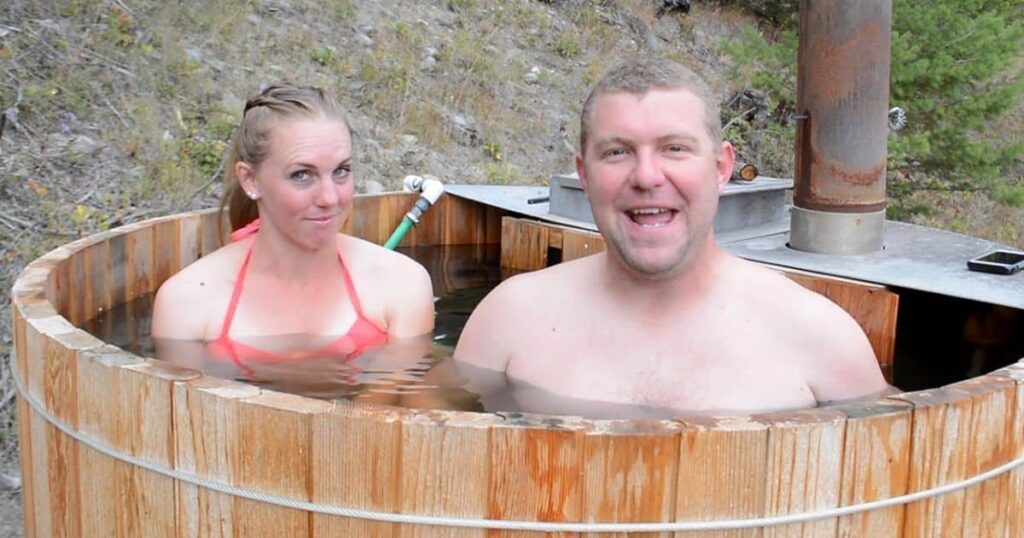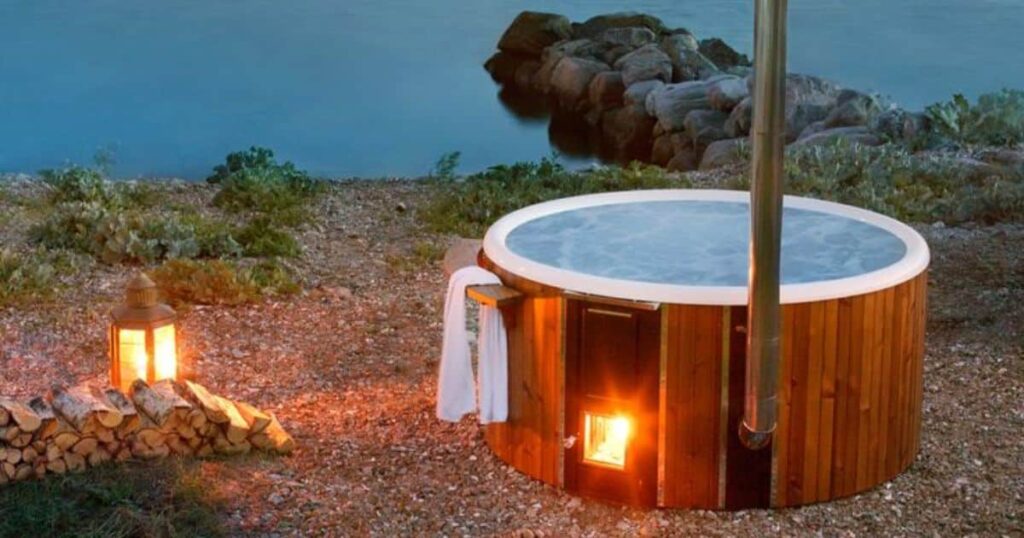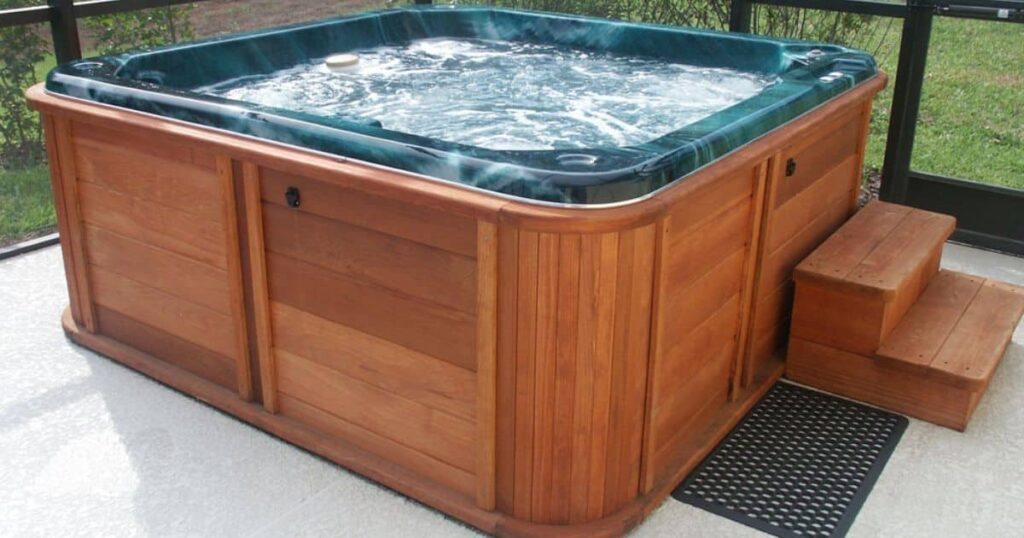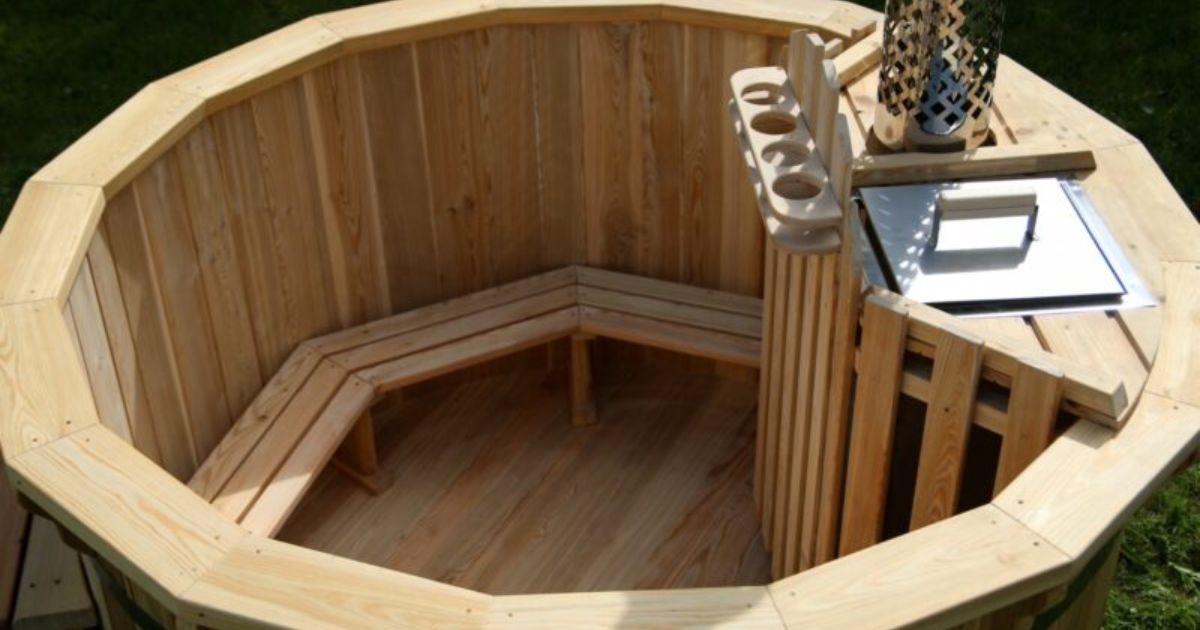Wood fired hot tubs are a unique way to enjoy soothing warm water outdoors. These tubs heat water using a wood burning stove located within or just outside the tub. This provides a rustic experience while being more environmentally friendly than electric options.
Imagine relaxing in your backyard soaking tub on a chilly evening, feeling the warmth of a cozy fire as it heats the water surrounding you. A wood fired hot tub creates an unbeatable outdoor spa experience different from any electric version.
Wood fired hot tubs work by having a wood or pellet burning stove located inside or near the tub. As the fire burns, it heats a coil of pipes filled with water. This heated water is then circulated through the tub to provide soothing warmth for soakers.
Pros of Wood-Fired Hot Tubs

Wood-fired hot tubs boast numerous advantages that make them an attractive option for homeowners seeking a unique bathing experience. Firstly, their unparalleled energy efficiency stands out, as they rely on natural resources like wood for heating, significantly reducing electricity consumption and operating costs. Additionally, these hot tubs offer faster heating times, allowing users to indulge in relaxing soaks without delay.
Their eco-friendly nature is another notable benefit, as they produce lower carbon emissions compared to their electric-heated counterparts. Moreover, wood-fired hot tubs are renowned for their reliability and longevity, promising years of enjoyment with minimal maintenance requirements. Overall, these pros make wood-fired hot tubs a compelling choice for those prioritizing sustainability, affordability, and rustic charm.
Energy Efficiency
Wood fired hot tubs require no electricity to function, making them extremely energy efficient. The heat from the fire directly transfers to the water without loss, providing an estimated 80-90% efficiency advantage over electric heaters.
Better Heating Time
It takes only about an hour for a wood stove to bring 200+ gallons of water up to the ideal 100-104°F soaking temperature. Electric heating elements are less powerful and can take 4-6 hours to reach the same temperature, wasting more energy in the process.
Cost
Due to having no electricity usage, the main expense for wood tubs is obtaining fuel like firewood or pellets. Over time, this ends up being significantly cheaper than running expensive electric elements daily or weekly to maintain hot water temperatures. Maintenance is also lower cost without pricey replacement parts.
Eco-Friendly
Burning renewable and sustainable firewood is a natural heating method that produces no emissions or pollution. It allows for an outdoor soaking experience with zero carbon footprint, harnessing the power of combustion in an environmentally conscious way compared to power-hungry electric heat sources.
Reliability
A properly installed and maintained wood stove will provide consistent heat output for decades. Simple mechanical operation means fewer issues arise over time compared to complex electric controls and heaters vulnerable to damage or breakdown. Reliable combustion provides peace of mind versus intermittent power supply disruptions disrupting electric tub use.
Lifespan
While electric hot tub components like pumps, jets and heaters need repairs or replacing every 5-10 years, a high-quality insulated wood fired hot tub structure can last 30+ years with only periodic wood stove maintenance. This immense durability makes the upfront investment worthwhile for long-lasting outdoor enjoyment.
Cons of Wood Fire Hot Tubs

Despite their many advantages, wood-fired hot tubs also come with a few drawbacks to consider. One significant concern is the requirement for outdoor placement due to the smoke and fumes generated during heating, which may not be suitable for all homeowners or locations. Safety is another consideration, as the open flame poses fire hazards, and the hot surfaces can present a burn risk if proper precautions are not taken.
Additionally, maintaining a wood-fired hot tub involves regular cleaning of ash and debris, as well as manual temperature control, which may require more effort compared to electric-heated models. These factors, along with the need for adequate ventilation, should be carefully weighed before investing in a wood-fired hot tub.
Placement/Fumes
Safety codes dictate hot tubs with combustion heat sources must be at least 10 feet from any building due to flue gases and potential fire risk. Ventilation is also needed within the tub structure itself. This limits ideal placement options more than self-contained electric tubs.
Safety Concerns
Open flames introduce safety hazards if not installed and operated properly. A certified chimney and stove are mandatory, along with keeping the fire enclosure and surrounding area clear of debris. Periodic safety inspections by a professional are wise due to risks of flue fires or carbon monoxide leaks.
Maintenance
Wood stoves require more hands-on upkeep like ash cleanout after each use, periodic creosote removal from the chimney, and replacing worn grates or door seals. Water treatment also demands more attention without built-in sanitizers. This ongoing maintenance is more labor intensive than electric models.
Temperature Control
Maintaining an even, adjustable water temperature takes practice compared to preset electric controls. The draft and wood load must be fine-tuned based on outdoor conditions and soaker preference. Overshooting or undershooting the ideal range can impact the experience until getting used to wood stove operation.
Pros of Electric-Heated Hot Tubs

Electric-heated hot tubs offer several enticing advantages that cater to modern convenience and customization preferences. One notable pro is their advanced features and precise temperature control, allowing users to tailor their bathing experience with digital controls, programmable settings, and integrated amenities like lighting and sound systems.
Moreover, their versatile installation options make them suitable for both indoor and outdoor settings, providing flexibility in placement. Additionally, electric-heated hot tubs tend to have a longer lifespan compared to wood-fired models, thanks to their durable electronic components. These features collectively contribute to a luxurious and hassle-free spa experience, appealing to those seeking comfort and convenience.
More Features/Control
Digital controllers enable fingertip customization of all tub functions from LED lighting to automated cleaning cycles. Preset temperatures free users from manually maintaining burner levels. Advanced accessories like audio systems further enhance relaxation without extra wood stove equipment.
Can Be Set Up in More Areas
Without location restrictions from flue vents, electric tubs can be situated almost anywhere with power access. This makes them more practical for smaller yards, patios or indoor poolside areas where combustible wood stoves would not be permitted or ideal.
Cons of Electric-Heated Hot Tubs

Despite their conveniences, electric-heated hot tubs come with a few drawbacks worth considering. One significant downside is their shorter lifespan compared to wood-fired alternatives due to the degradation of electronic components over time. Maintenance and repairs of these components can incur additional costs for homeowners, making them a less economical option in the long run.
Moreover, electric-heated hot tubs are generally less eco-friendly than wood-fired models, relying on grid electricity that may be sourced from fossil fuels. Additionally, they often take longer to heat up, especially in colder climates, which may inconvenience users seeking immediate relaxation. These factors should be carefully weighed against the benefits when deciding on an electric-heated hot tub.
Shorter Lifespan
Electric components steadily break down and need replacing every 5-10 years on average. Heat sources, controls and mechanicals like pumps all have finite lifespans and warranties. Over 20+ years, multiple component replacements drive up the total cost of ownership much higher than lower maintenance wood fire tubs.
Less Eco-Friendly
While more convenient, relying solely on electricity means continuously producing greenhouse gas emissions at the source of power generation. Wood, on the other hand, is a renewable resource. Over time, the environmental impact of powering versus burning for heat is substantial in overall carbon footprint.
Costs More to Run
Electricity rates continue rising annually on average. Powering heaters, jets and accessories daily or weekly becomes very costly long-term versus the low fuel expense of burning natural, sustainable firewood. Total operational expenses over 10+ years of tub ownership favor non-electric solutions.
Takes Longer to Heat Up
It typically takes a minimum of 4 hours for uninsulated electric elements to bring 200+ gallons from cold tap temperatures up to the ideal 100-104°F range. Waiting half a work day limits spontaneous hot tub use, versus the convenience of wood stoves heating fast for instant relaxation.
Conclusion
Both wood fired and electric hot tubs offer tradeoffs between their respective strengths and weaknesses. Wood provides an eco-friendly, cost-effective heating method better suiting those who enjoy a slower, manual spa experience. However, its maintenance demands more hands-on labor. Electric tubs allow set-it-and-forget convenience with a wide array of cutting-edge features in any location. Their longevity suffers more while costing more to power long-term. Overall, wood remains the better value proposition and natural choice for those willing to tend its fire regularly for fast, renewable hot water heating.








